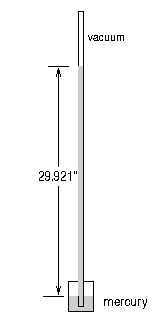|
the absolute barometric pressure is 20.85 inches of mercury The boiling point at that pressure is 194.24° F. Double, double, toil and trouble fire burn and cauldron bubble. Why do we care about the boiling point of water anyway?
So how are barometric pressure and elevation related to the boiling point of water?  First off, there are two different meanings of the term
"barometric pressure" depending on context, and that's what can make it
confusing at times. In order to answer the question at hand, we'll need
to find out how the weatherman's definition differs from the absolute
pressure.
First off, there are two different meanings of the term
"barometric pressure" depending on context, and that's what can make it
confusing at times. In order to answer the question at hand, we'll need
to find out how the weatherman's definition differs from the absolute
pressure.
Originally, a barometer was a very simple device consisting of a glass tube about 32" long, closed at one end, and a beaker of mercury. The glass tube was filled completely with mercury, and then inverted into the open beaker of mercury. Of course there was support and adjustment hardware, but the main point is that the distance between the mercury levels in the beaker and in the tube is equal to atmospheric pressure. As weather fronts come and go, the mercury is pushed up into the tube a bit more, or drops a little back into the beaker. If you have this kind of barometer, you can forget about elevation, what the weatherman says, etc. Whatever the difference is between the two levels of mercury -- the absolute barometric pressure -- can be entered in this simple absolute atmospheric boiling calculator. The second meaning of barometric pressure is the one the weatherman uses. Weather patterns are determined by comparing barometric pressures and "connecting the dots" to form isobars, which show what kinds of systems are forming where. If absolute pressure were used, the weather maps would be pretty much useless since higher elevations would always show lower pressures than sea level. Such a map would be much more useful topographically than in predicting weather. In order to compare readings at sea level with readings at higher elevations, all weather service barometric readings are "projected" to sea level. In other words, when the simple barometer above is at 5000' and reads 24.9" the weatherman makes the sea-level compensation, and then broadcasts the "official" barometric pressure of 29.92". Since this is a "sea level equivalent" it does us no good in determining boiling points unless we're at sea level... so we have to convert it back to absolute pressure in order for it to be useful in this context. That's what the calculator at the top of this page does; converts the "official" barometric pressure back to absolute, and then determines the boiling point based on that. Site Map The no-frills and SI calculator |